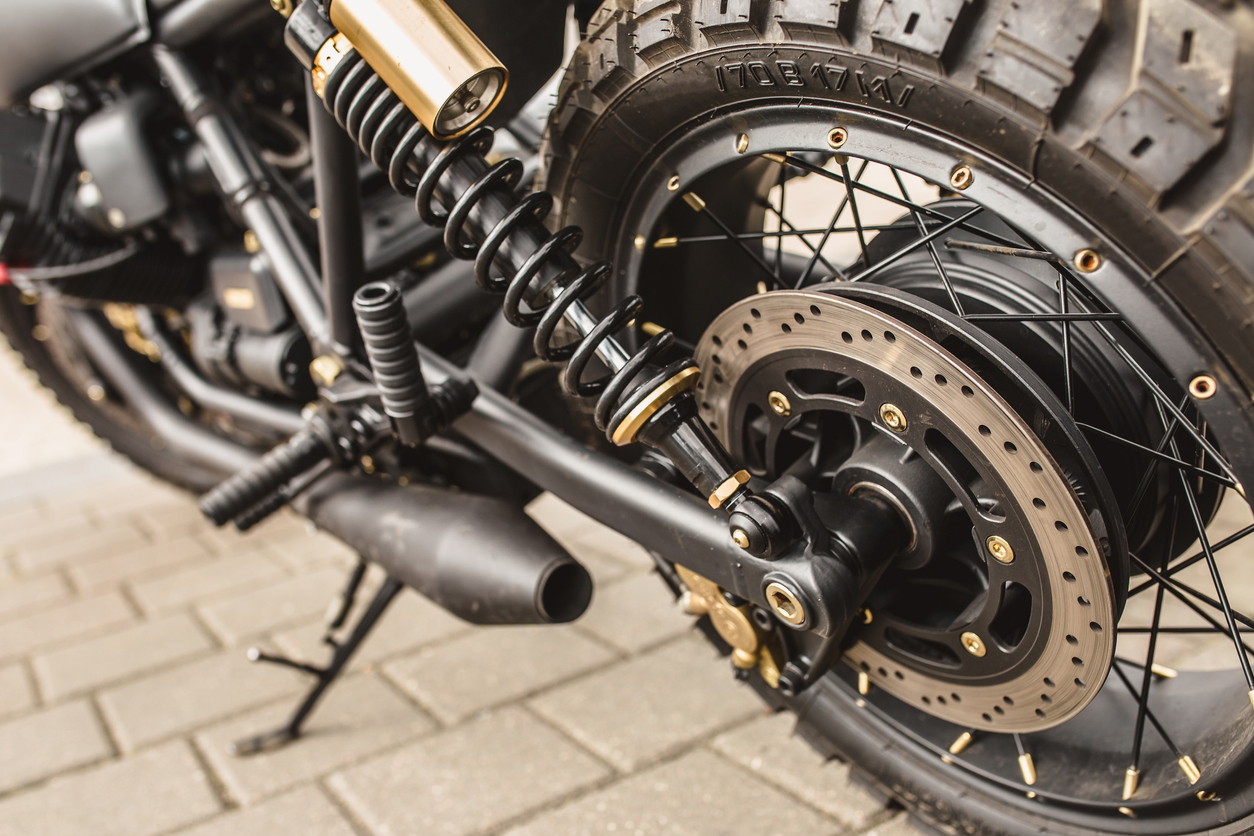I. The Mysterious Structure of Motorcycle Shock Absorbers
(I) Spring Components
- Coil Spring
- The springs in motorcycle shock absorbers usually come in types such as coil springs and torsion bars, with coil springs being the most common. Generally made of spring steel, they possess excellent elasticity and fatigue resistance. The wire diameter of the spring ranges from 8mm to 16mm. Different wire diameters are selected according to the type, weight, and design requirements of the motorcycle. The number of coils is mostly around 8 to 15. The number of coils affects the stiffness of the spring. The stiffness coefficient of the spring is generally between 20N/mm and 100N/mm. The greater the stiffness, the stronger the support force for the vehicle, but the comfort may be reduced.
- Spring Precompression
- When installed, the spring has a certain amount of precompression. For most motorcycle shock absorbers, the precompression amount is between 10mm and 30mm. The precompression setting is mainly to adapt to the static load of the motorcycle, so that the vehicle maintains an appropriate height when stationary and can better handle various road conditions during driving.
(II) Damping System
- Damping Oil
- The damping system is filled with damping oil. Common damping oils include mineral oil and synthetic oil. Mineral oil is relatively inexpensive, but its performance stability in high and low temperature environments is not as good as that of synthetic oil. Synthetic oil has better oxidation resistance, abrasion resistance, and viscosity-temperature characteristics. The viscosity of damping oil is generally between 5W and 20W. Select the appropriate viscosity of damping oil according to the design of the shock absorber and the vehicle’s use. The capacity of damping oil in the shock absorber varies depending on the shock absorber model, generally between 100ml and 300ml.
- Piston and Valve
- The piston moves reciprocally in the inner cylinder of the shock absorber and controls the flow of damping oil through the small holes and valves on the piston. The diameter of the small holes on the piston is usually between 1mm and 3mm. The opening pressure of the valve is generally between 0.5MPa and 2MPa. When the shock absorber is compressed, the damping oil flows from one chamber to another through the small holes and compression valves on the piston, generating compression damping force. When the shock absorber rebounds, the damping oil flows through the rebound valve, generating rebound damping force. By adjusting parameters such as the valve aperture and spring preload, the magnitude of the damping force can be changed to adapt to different driving needs and road conditions.
(III) Shock Absorber Housing and Connectors
- Housing Material
- The shock absorber housing is generally made of aluminum alloy or steel pipe. Aluminum alloy housing has the advantages of light weight and corrosion resistance, but its strength is slightly lower than that of steel pipe. Steel pipe housing has high strength and durability but is relatively heavier. The wall thickness of the housing is between 2mm and 5mm. Different materials and design requirements will have different wall thicknesses.
- Connectors
- The connectors of the shock absorber to the frame and wheels are crucial. The upper connection is generally connected by a ball joint or rubber bushing. Ball joint connection can provide more precise steering control but requires regular maintenance and lubrication. Generally, the wear condition of the ball joint needs to be checked every 5000 kilometers and an appropriate amount of lubricating grease needs to be added. The lower connection is usually fixed by bolts. The diameter of the bolts is generally between 8mm and 14mm. The torque requirement is between 30N·m and 80N·m according to different vehicle models.

II. Working Principle of Motorcycle Shock Absorbers
(I) Compression Stage
When the motorcycle encounters bumps and the shock absorber is compressed, the spring is compressed first and absorbs part of the energy. At the same time, the damping oil flows from one chamber to another through the small holes and compression valves on the piston, generating damping force. The damping force consumes part of the energy and makes the compression process of the shock absorber more stable, reducing the bumpiness of the vehicle.
(II) Rebound Stage
After the shock absorber is compressed, when the external force disappears, the spring starts to rebound and pushes the piston upward. At this time, the damping oil flows through the rebound valve, generating rebound damping force. The function of the rebound damping force is to control the rebound speed of the spring and prevent the vehicle from bouncing unstably due to the spring rebounding too quickly. By reasonably adjusting the magnitudes of the compression damping force and rebound damping force, the motorcycle can maintain good stability and comfort during driving.

III. Maintenance Secrets of Motorcycle Shock Absorbers
(I) Appearance Inspection
- Inspection Frequency
- After every 500 kilometers of riding, the appearance of the shock absorber should be inspected. Check whether the shock absorber housing has scratches, deformations, or corrosion. If there are slight scratches on the housing, they can be gently polished with sandpaper and then coated with anti-rust paint. For deep scratches or deformations, the shock absorber should be replaced in time to avoid affecting its performance and safety.
- Oil Seal Inspection
- At the same time, check whether there are signs of oil leakage from the oil seal. The oil seal is a key component to prevent damping oil leakage. If there are oil stains around the oil seal, clean them first and then observe whether the oil stains continue to appear. If the oil stains continue to appear, it may be that the oil seal is damaged and needs to be replaced. When replacing the oil seal, ensure correct installation. The installation depth of the oil seal is generally between 5mm and 10mm, and an appropriate amount of sealant should be applied. The amount of sealant is generally around 2g to 5g.
(II) Damping Oil Replacement
- Replacement Cycle
- Generally, the damping oil needs to be replaced every 10,000 kilometers or every two years (whichever comes first). When replacing the damping oil, the shock absorber should be removed from the motorcycle first. After removal, invert the shock absorber, unscrew the oil drain bolt at the bottom, and completely drain the old damping oil. Then use a special cleaning solvent to clean the inside of the shock absorber. The amount of cleaning solvent is generally around 50ml to 100ml. After cleaning, use compressed air to dry it.
- Oil Quantity Control
- When adding new damping oil, add an appropriate amount of damping oil according to the shock absorber model and the instructions. Generally speaking, the oil filling amount for each front shock absorber is between 150ml and 250ml, and for each rear shock absorber, it is between 100ml and 200ml. After adding oil, press the shock absorber repeatedly to make the damping oil fully fill the internal space and expel air.
(III) Spring Maintenance
- Cleaning and Rust Prevention
- Clean the spring every 2000 kilometers. Use a soft cloth dipped in a small amount of cleaner to wipe the surface of the spring to remove dust and dirt. Then apply a thin layer of anti-rust oil. The thickness of the anti-rust oil should be controlled between 0.05mm and 0.1mm to prevent the spring from rusting.
- Spring Performance Inspection
- Regularly check the performance of the spring, such as whether the elasticity of the spring is weakened. A preliminary judgment can be made by comparing the height of the vehicle when stationary with the original height. If the vehicle height is significantly reduced, it may be that the spring elasticity is decreased. You can also use a spring dynamometer to measure the stiffness of the spring and compare it with the original stiffness data. If the spring stiffness changes by more than 10%, consider replacing the spring.
(IV) Connector Maintenance
- Ball Joint Lubrication
- For the parts connected by ball joints, lubrication is required every 5000 kilometers. Use special ball joint lubricating grease. The injection amount of lubricating grease is generally between 3g and 5g. Evenly apply the lubricating grease on the surface of the ball joint and then move the ball joint to make it fully lubricated.
- Bolt Tightening
- Regularly check the tightness of the connecting bolts. Check once every 2000 kilometers of riding. Use a torque wrench to tighten according to the specified torque value. As mentioned earlier, the torque requirement of the bolts is between 30N·m and 80N·m according to different vehicle models. If the bolts are loose, it may lead to unstable connection of the shock absorber and affect riding safety.
By deeply understanding the structure and principle of motorcycle shock absorbers and strictly following the maintenance methods, we can keep the motorcycle shock absorbers in good performance all the time and bring us a comfortable and safe riding experience. Whether on a flat road or a rugged mountain road, a good suspension system is an indispensable and important part of a motorcycle. Let’s take good care of motorcycle shock absorbers and enjoy every wonderful riding journey.


Very fantastic info can be found on weblog. “Search others for their virtues, thyself for thy vices.” by Benjamin Franklin.